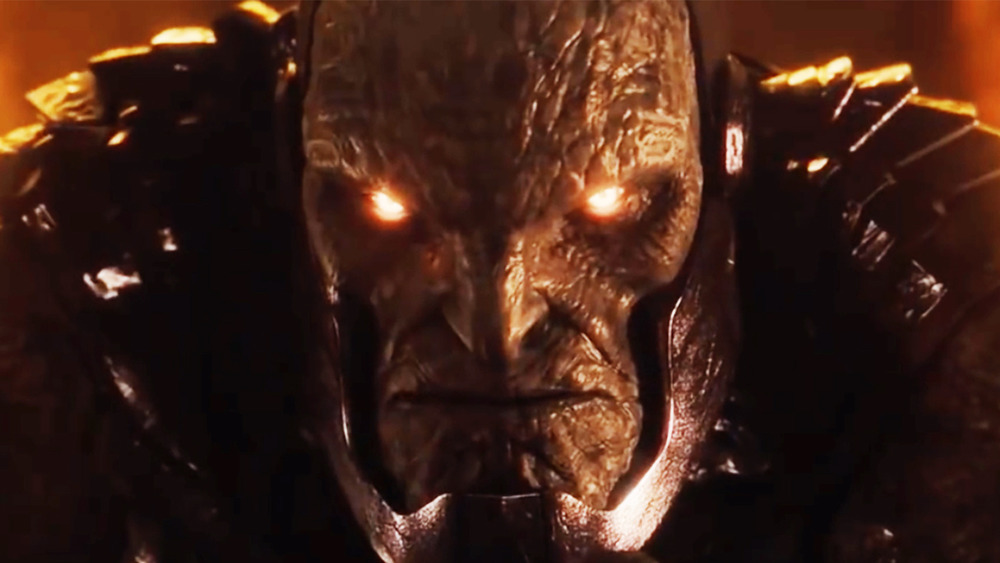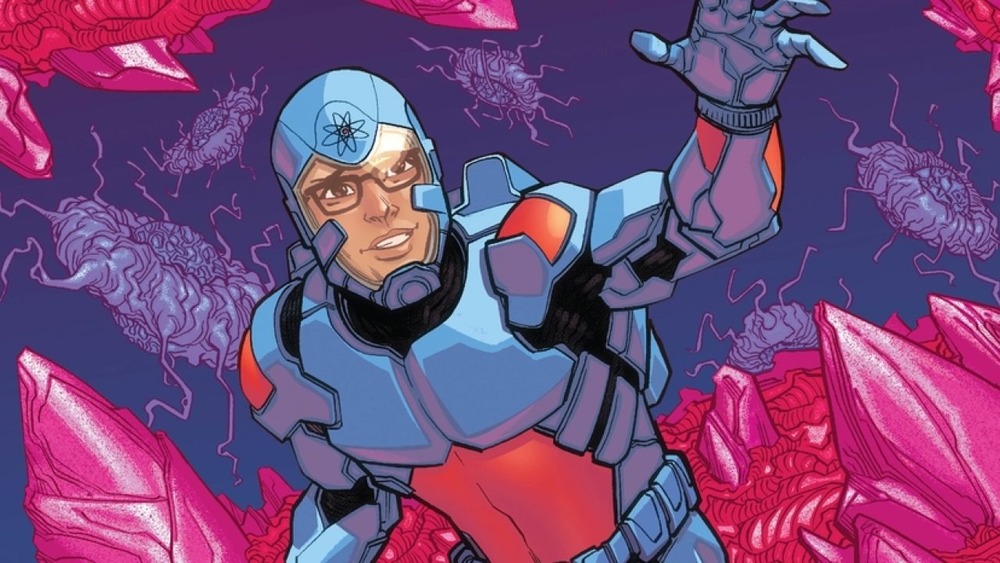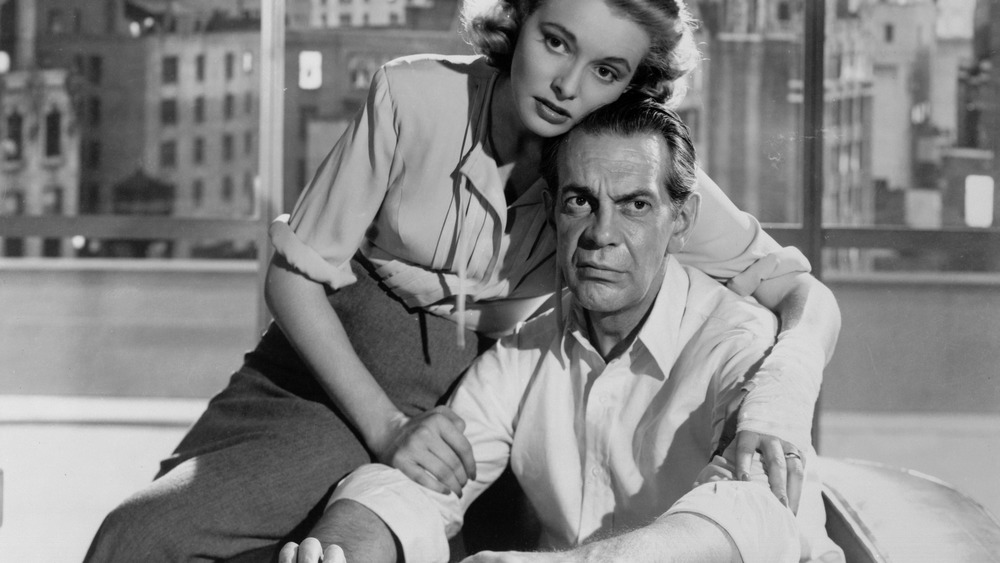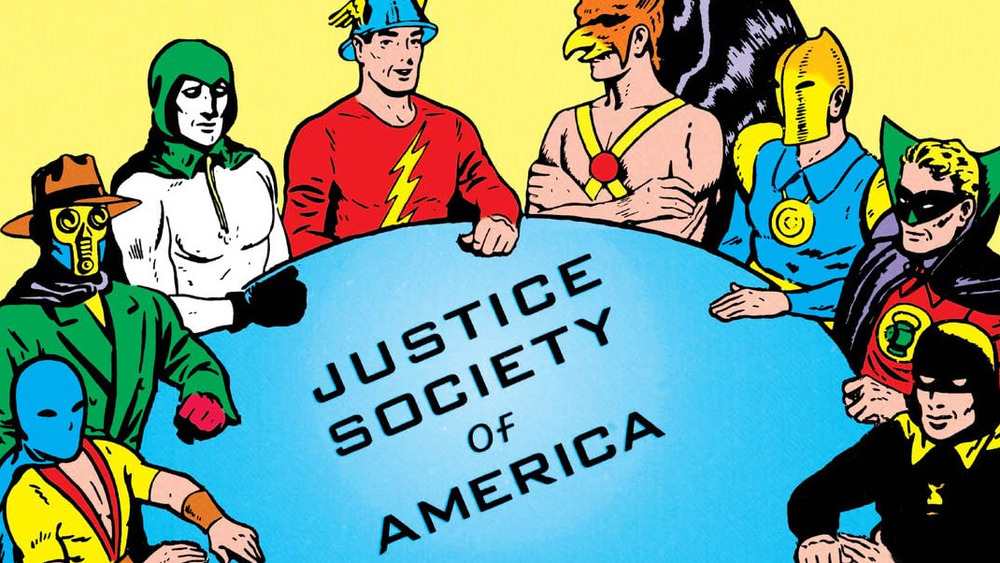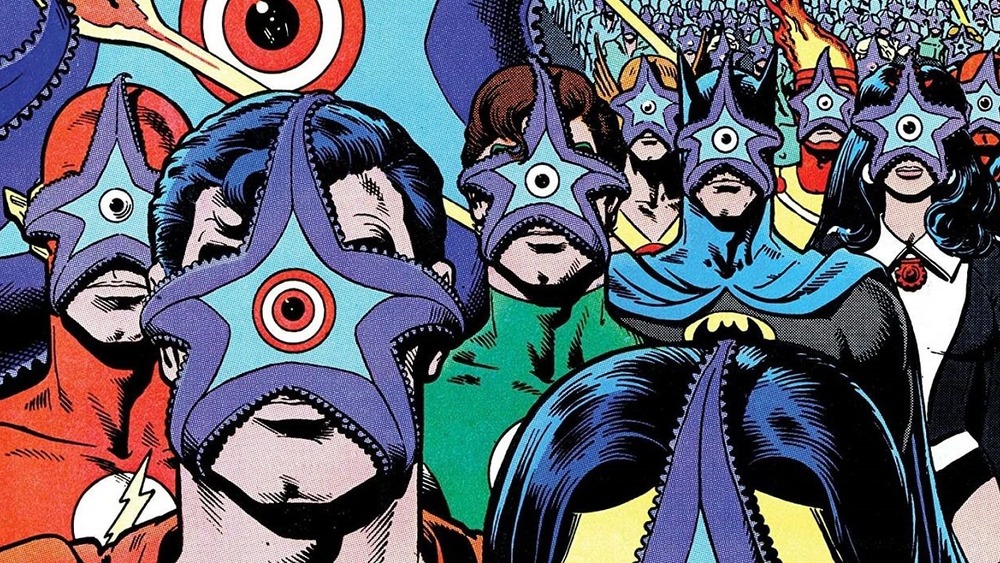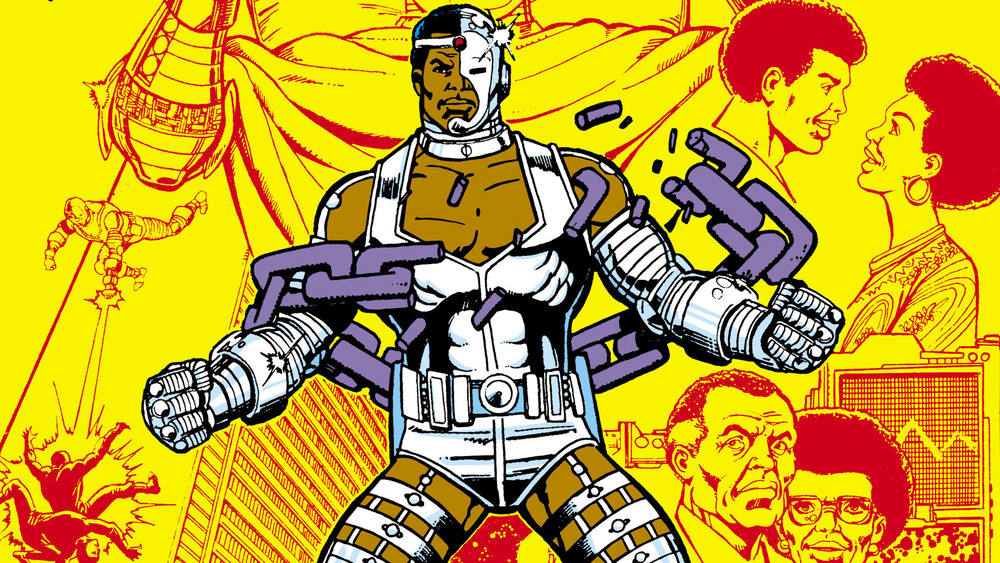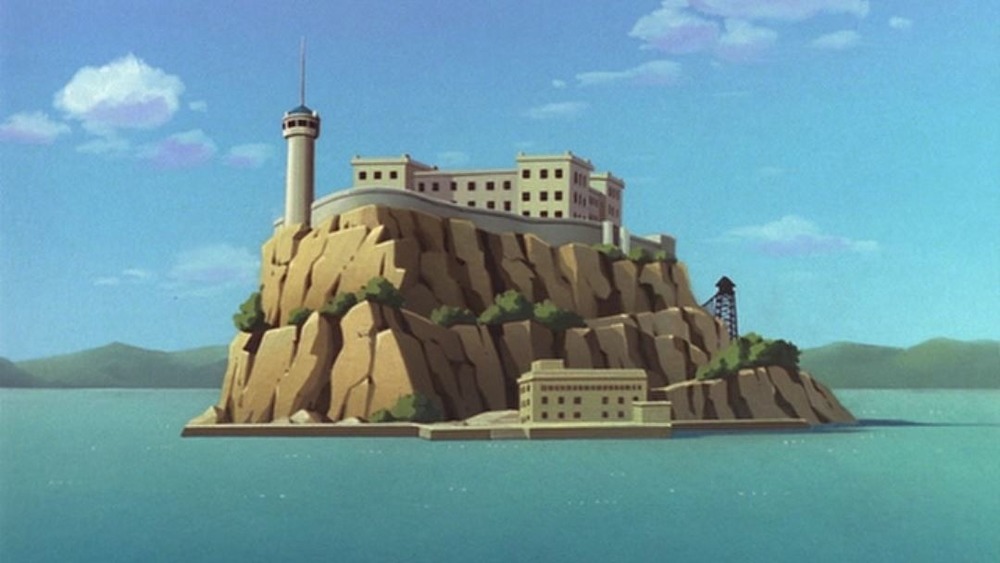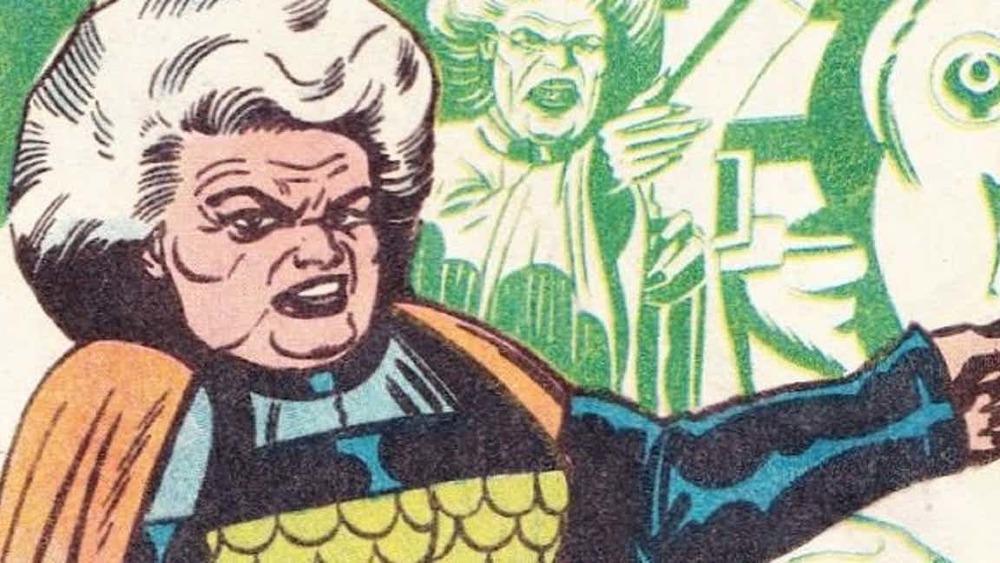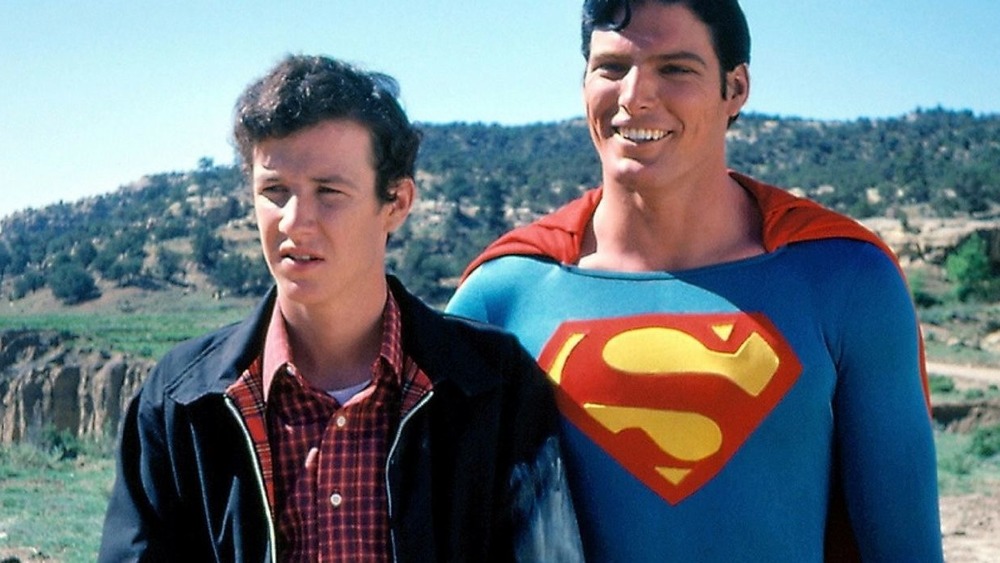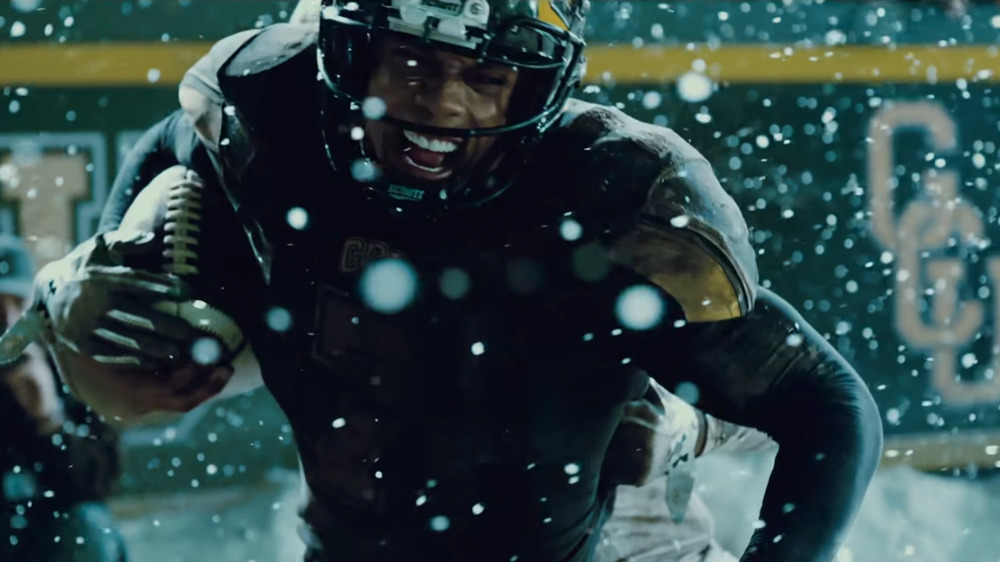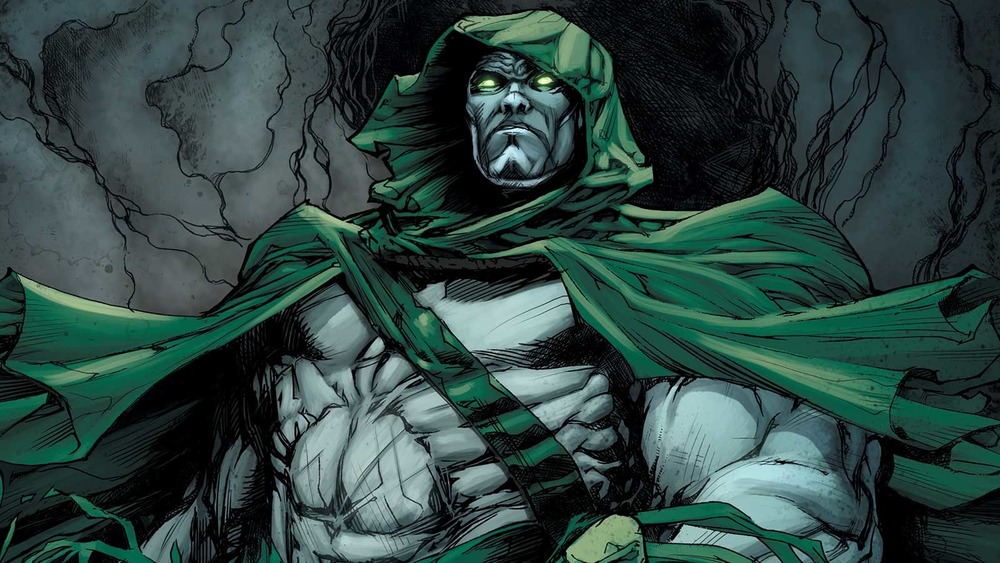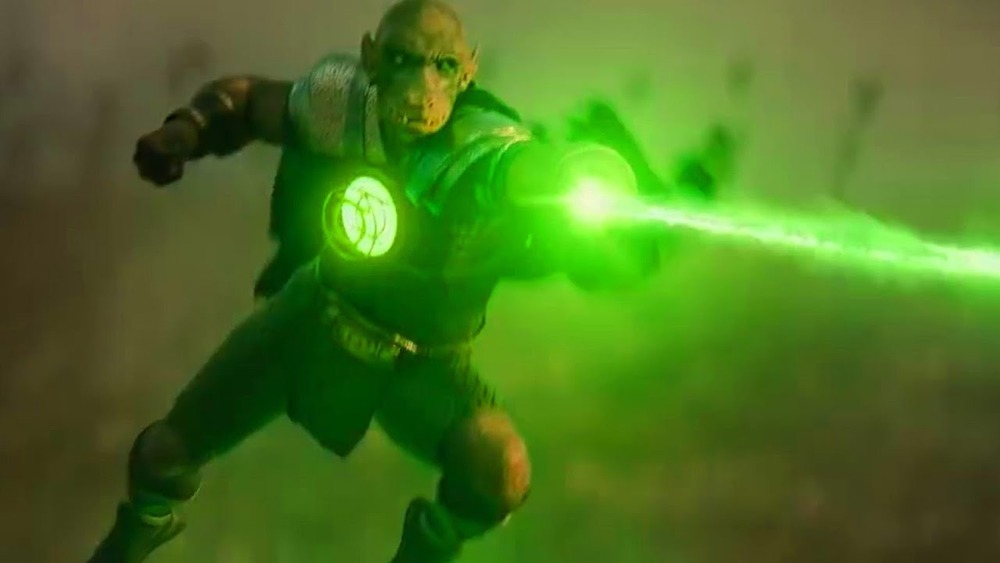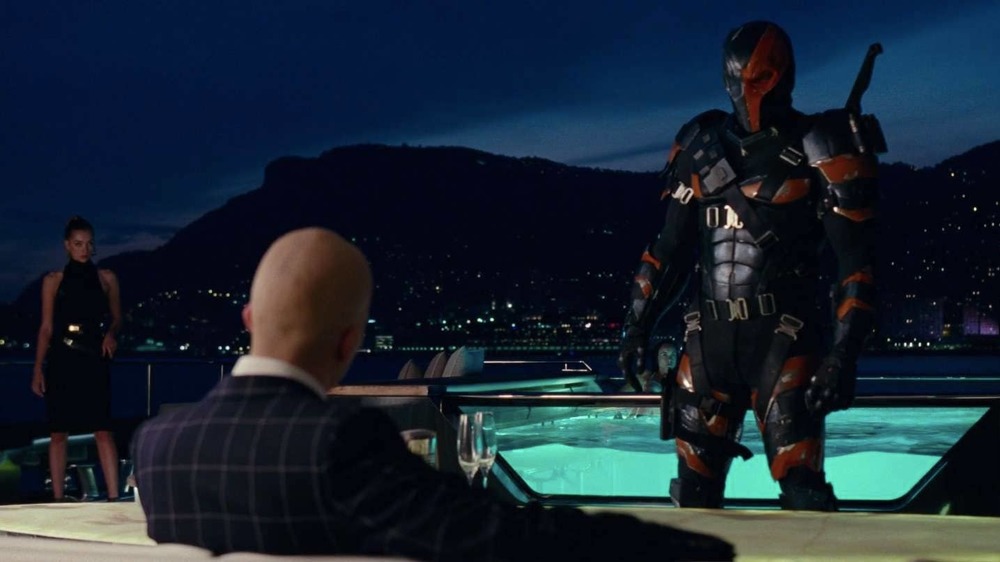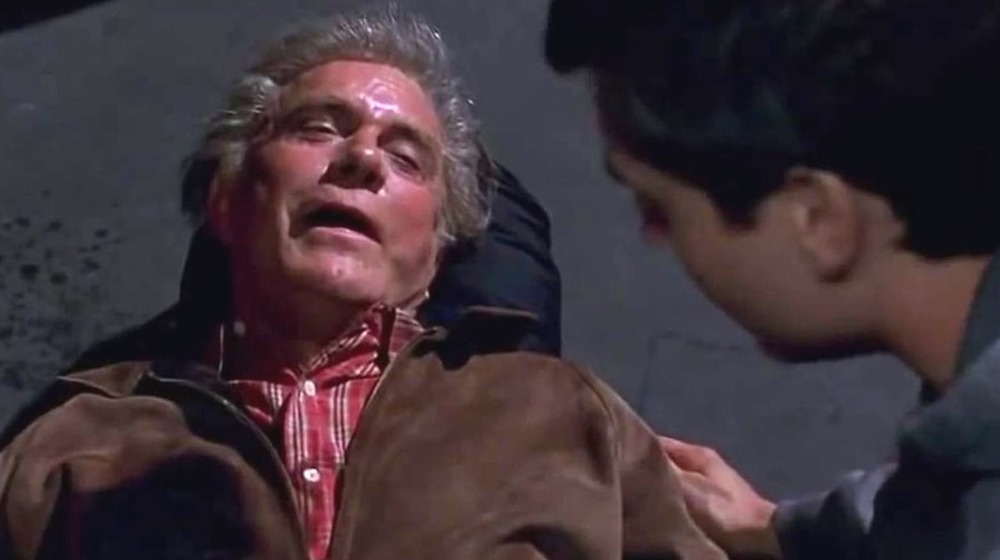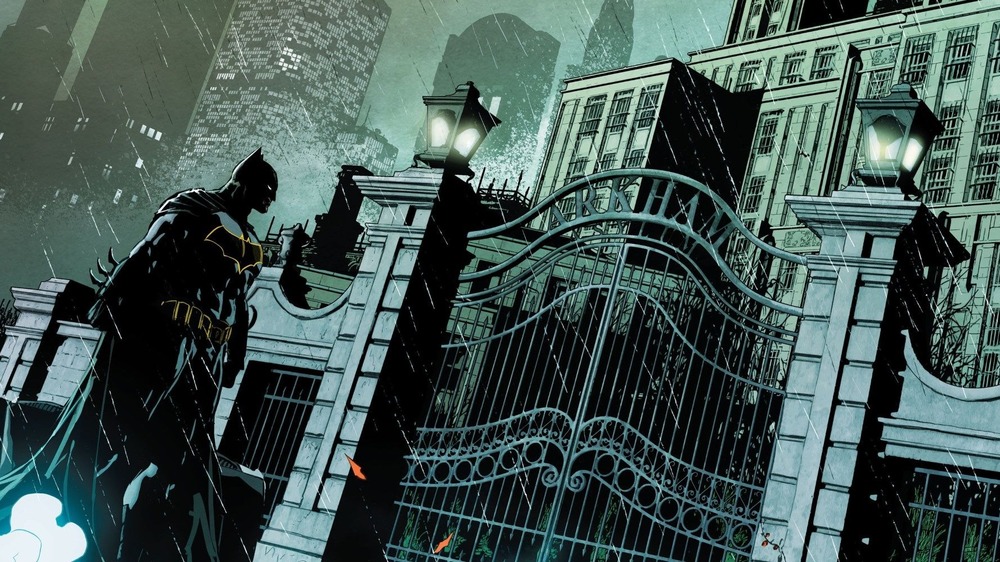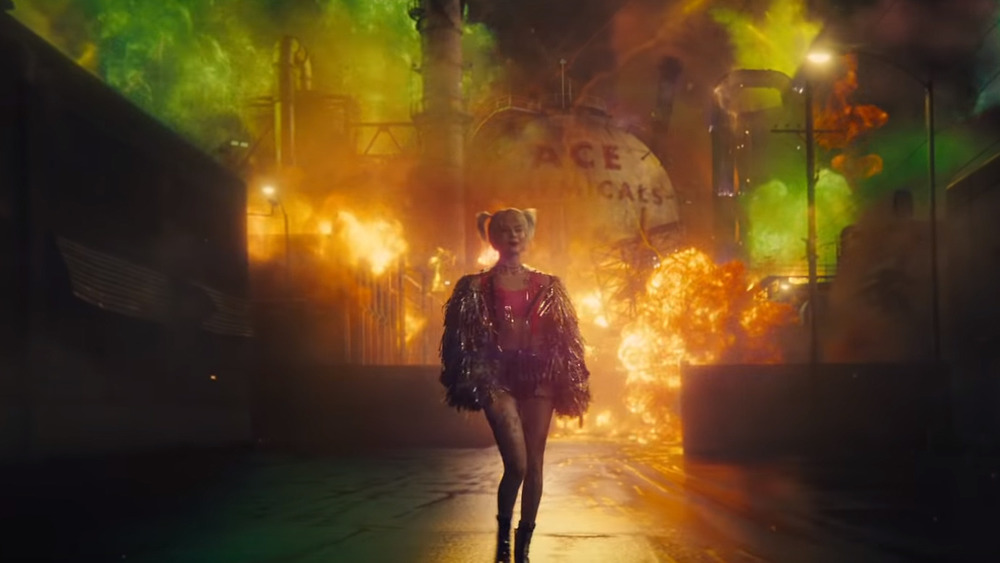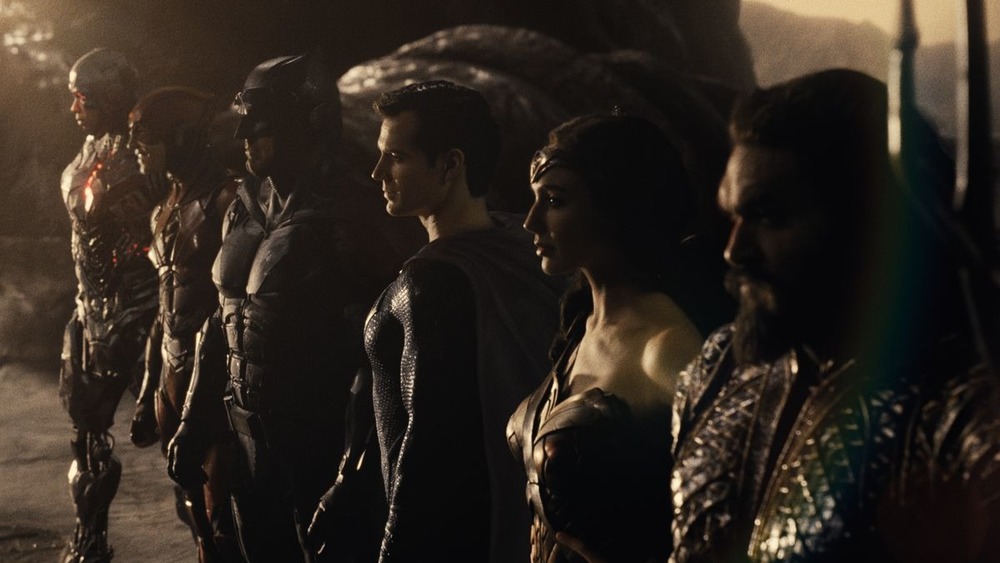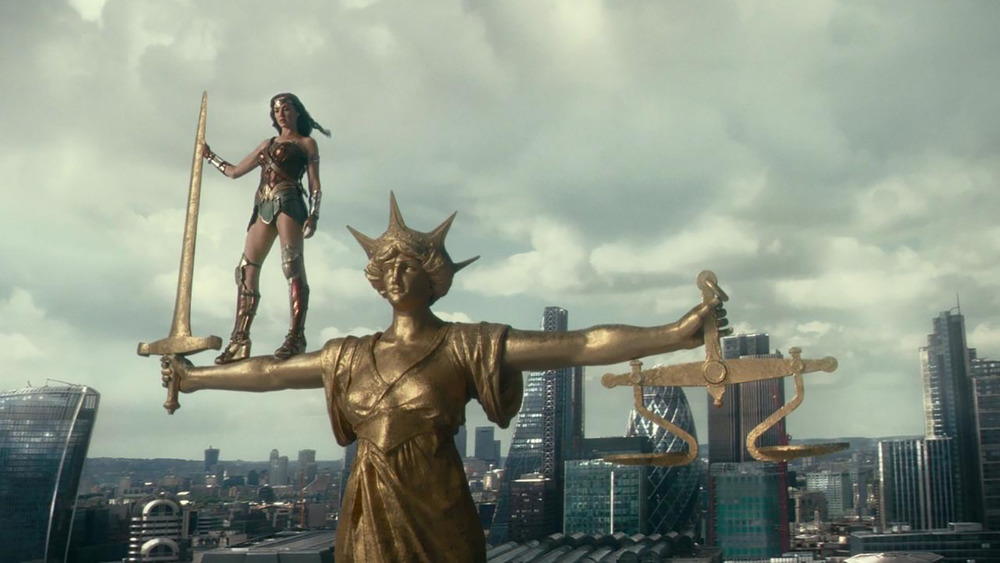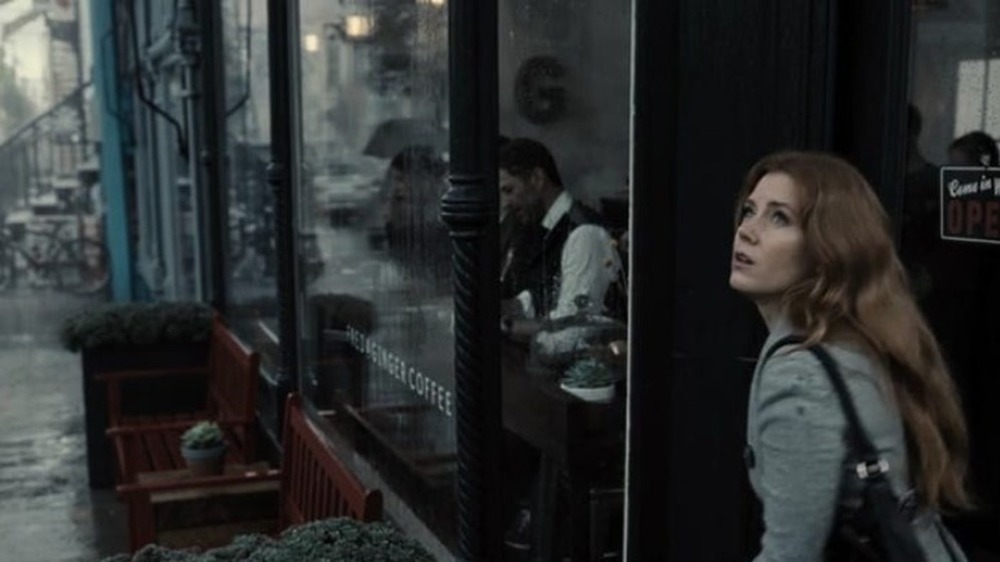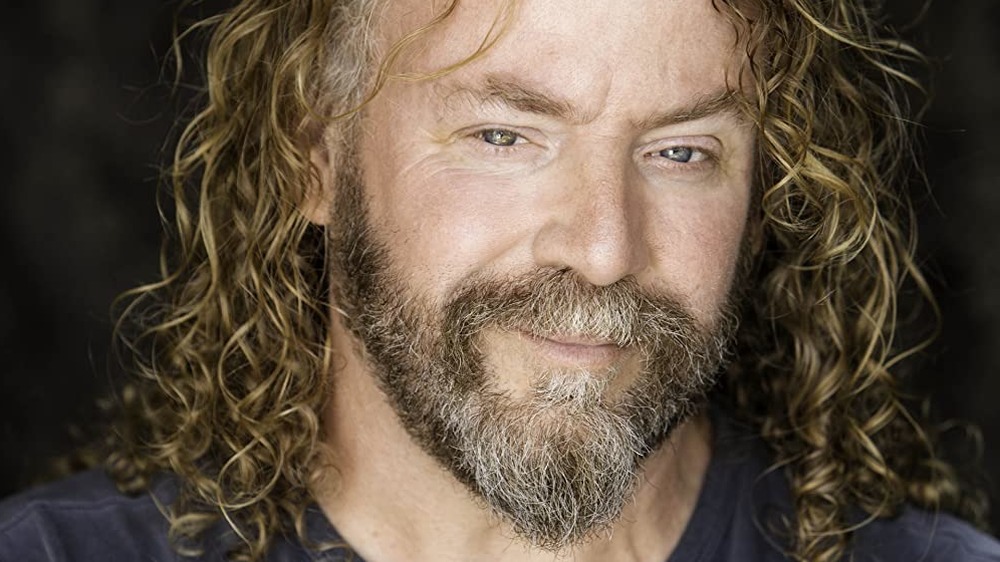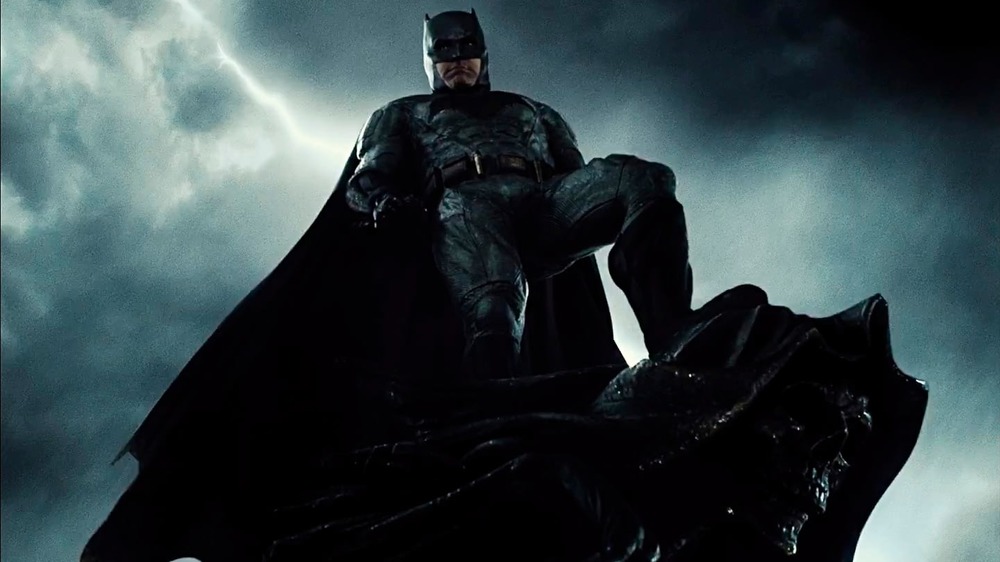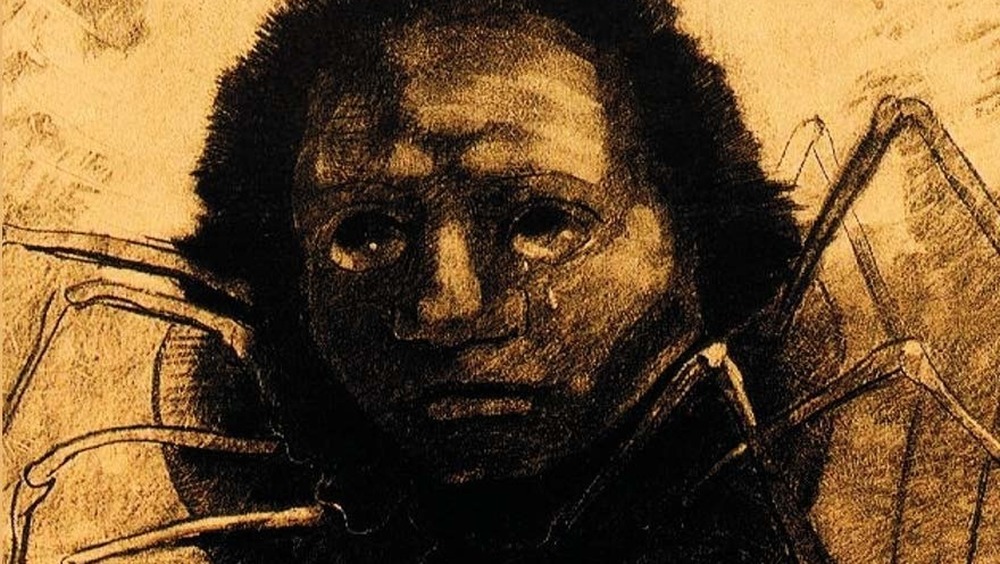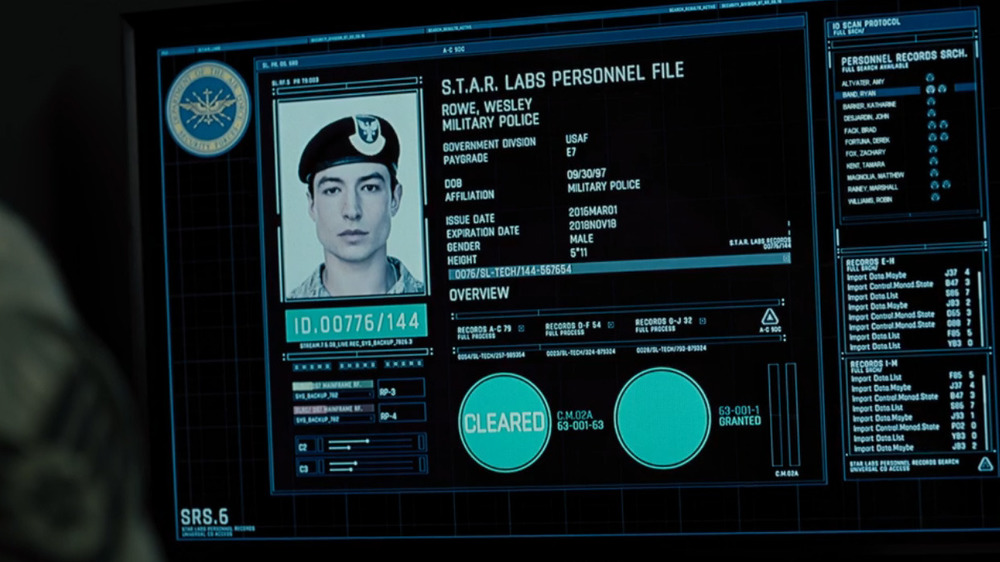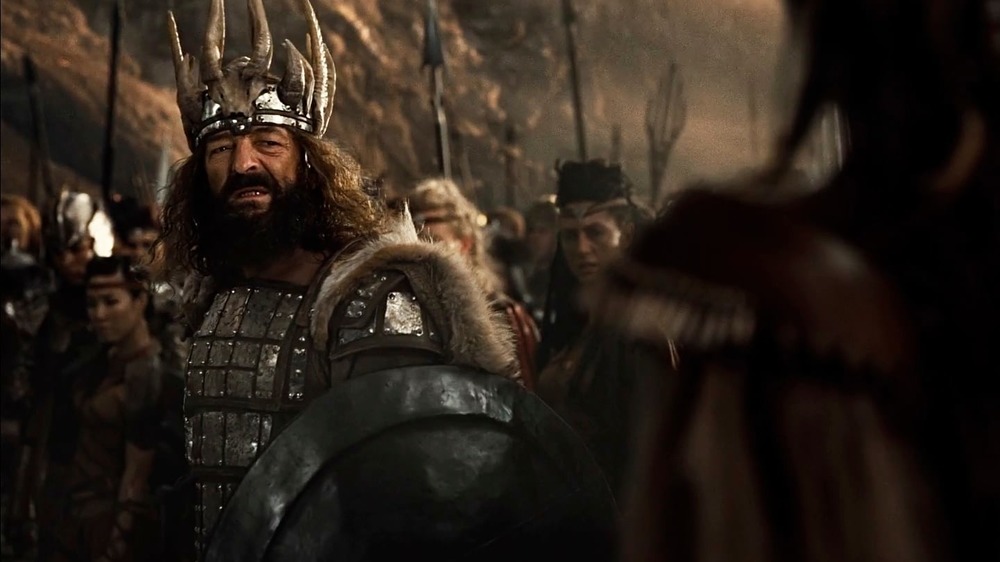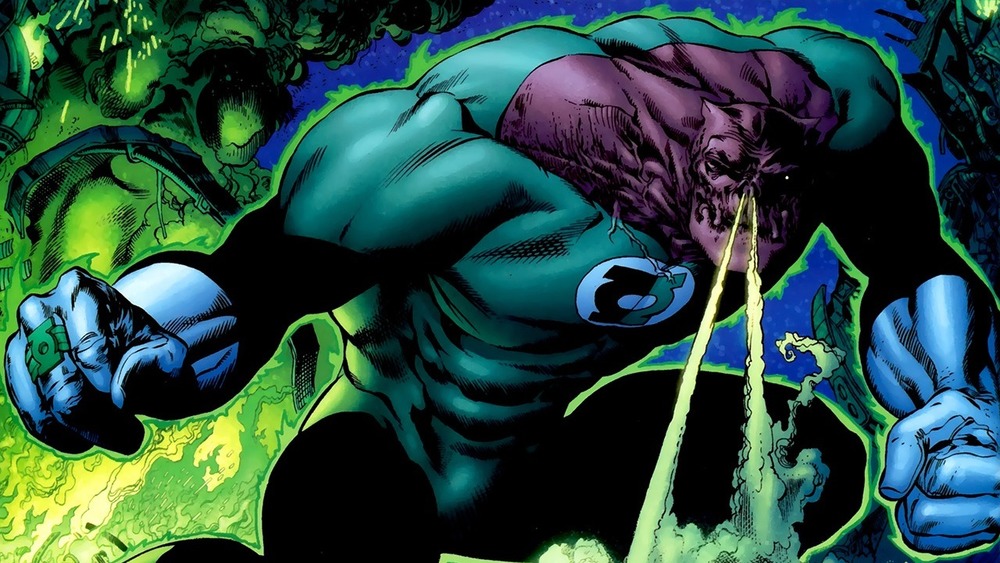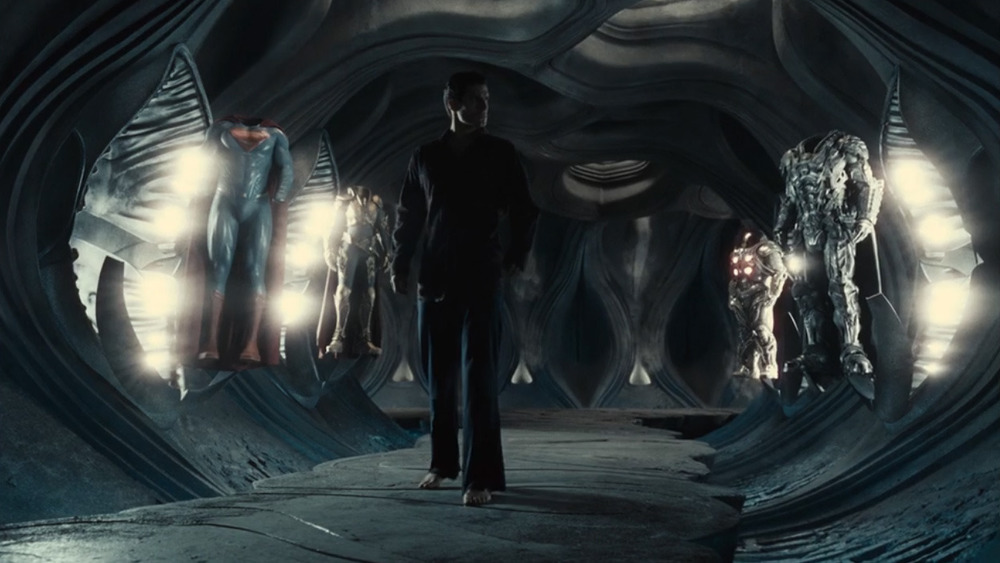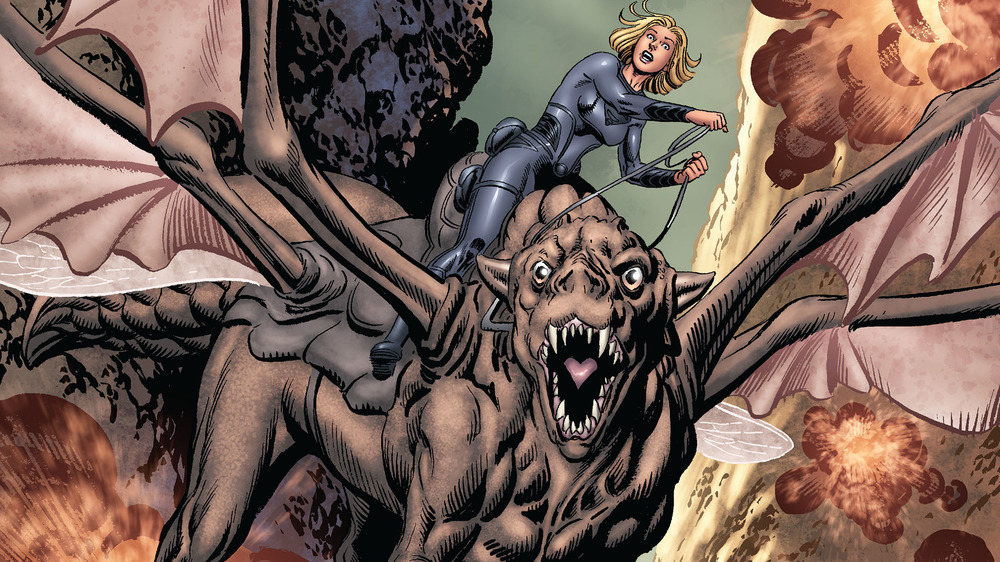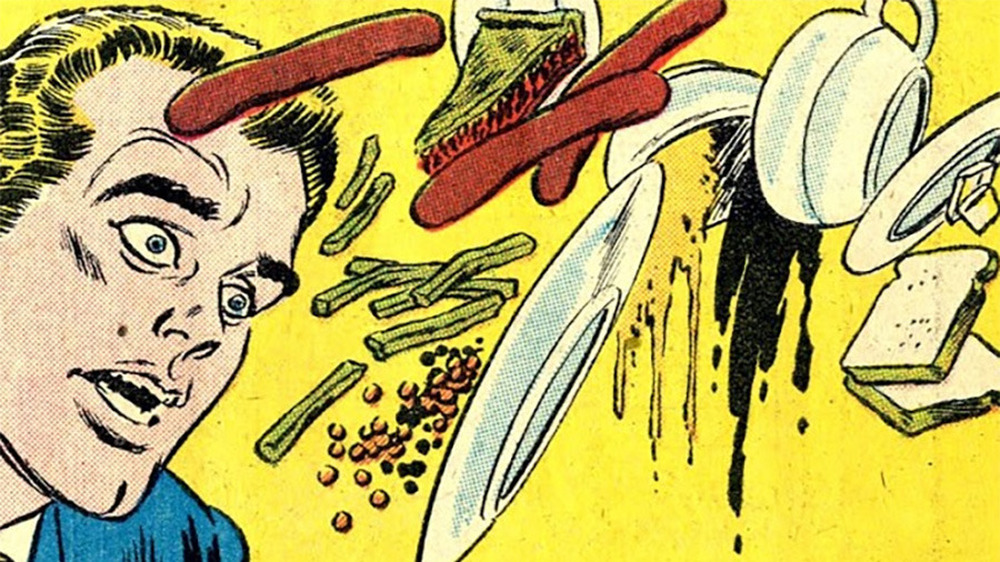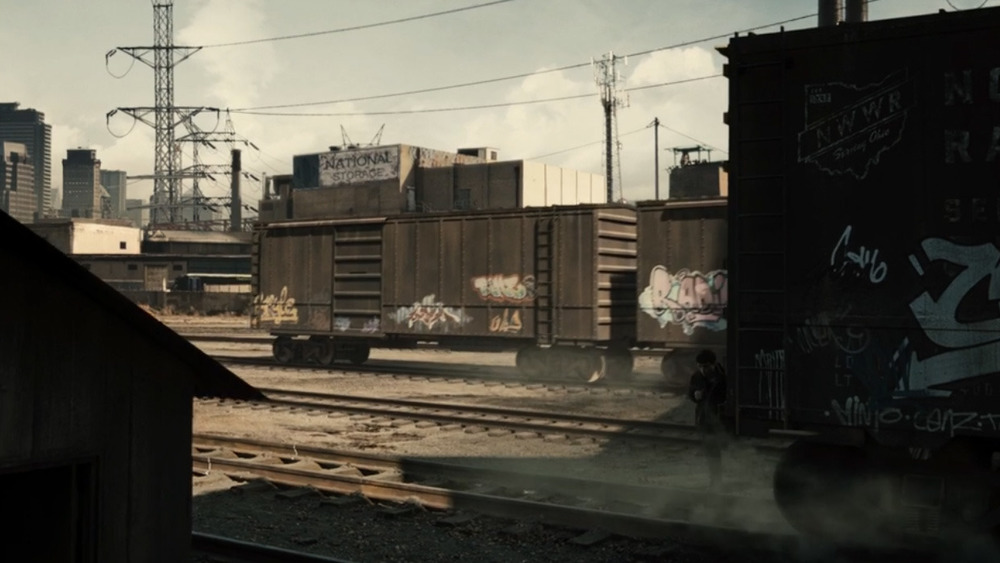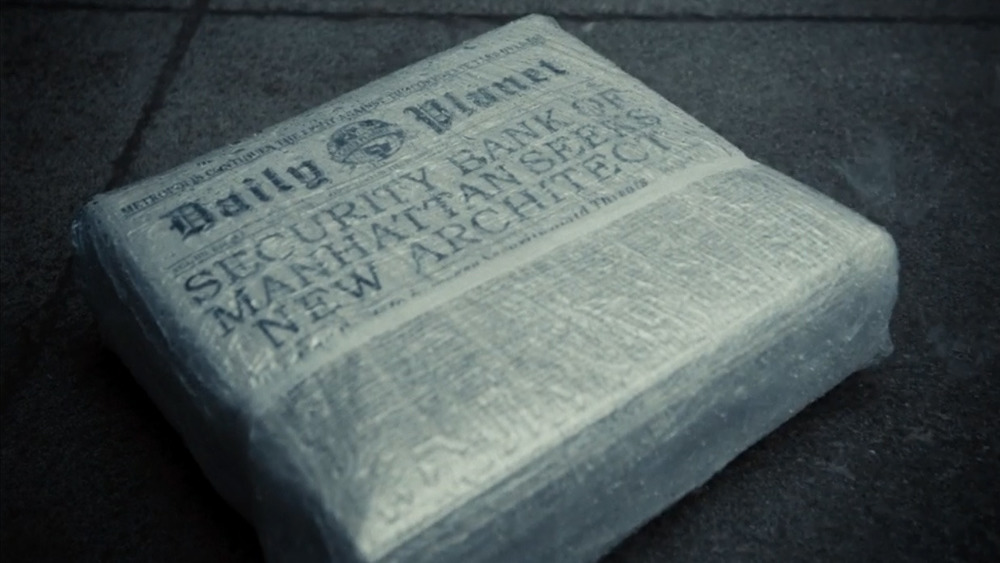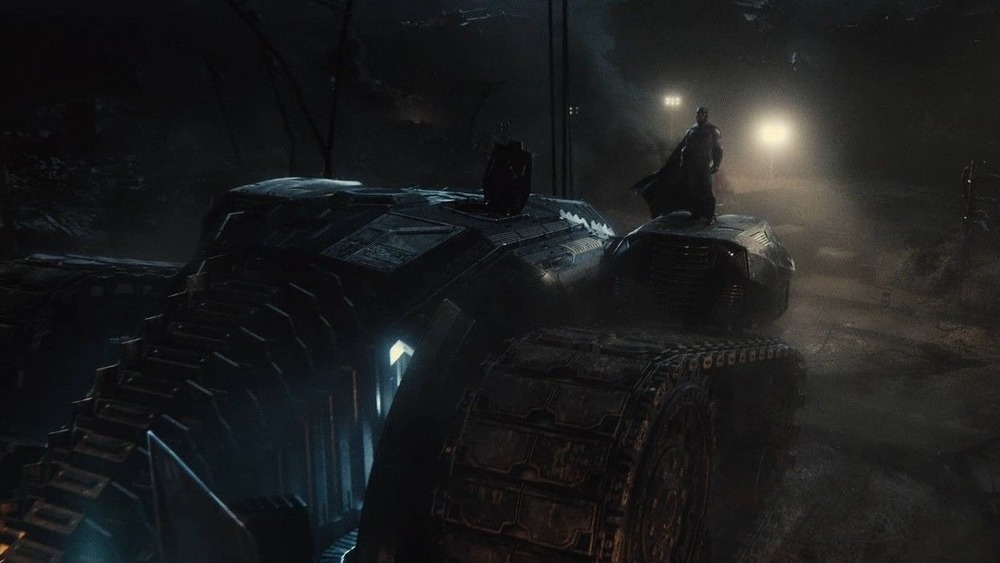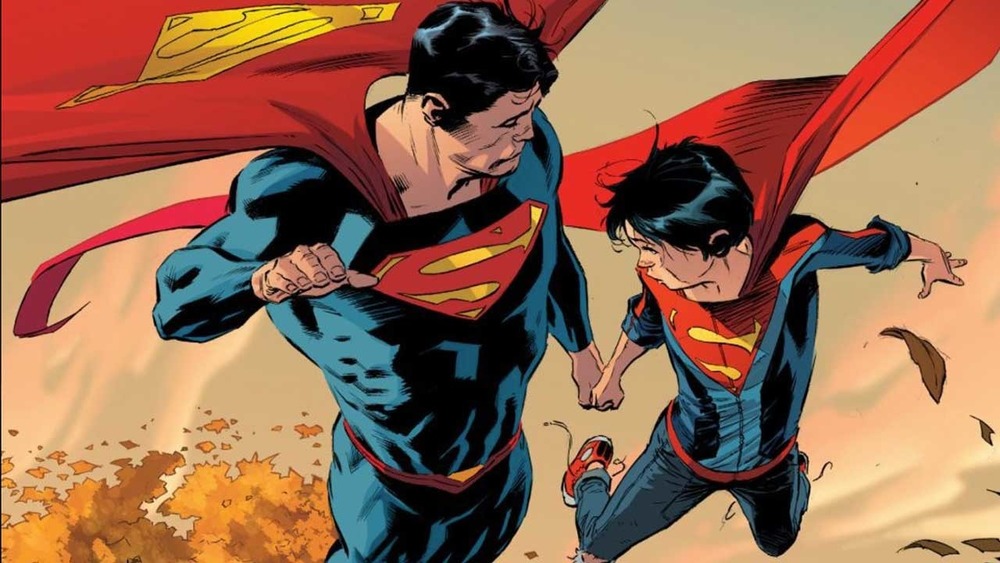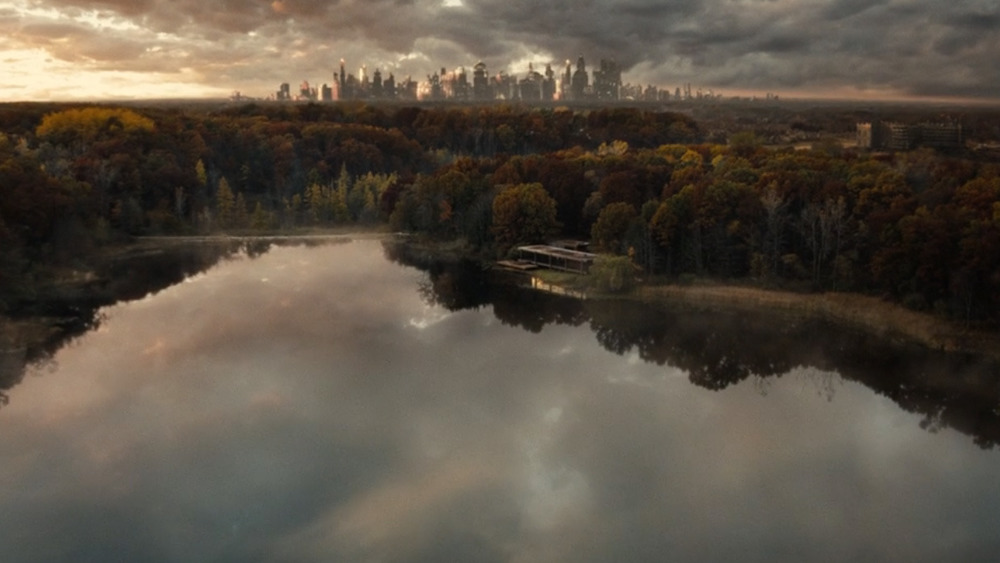Easter Eggs You Missed In Zack Snyder's Justice League
Whether you've seen the original theatrical release of Justice League or not, Zack Snyder's massive re-edit, known to fans as the Snyder Cut, is here to give you more. More heroes. More villains. More breathtaking action scenes. More of DC's pantheon of classic characters, exercising their god-like abilities for good and evil. More of Snyder's singular, signature take on DC's massive superhero universe, and, of course, lots more Easter eggs.
Look, Zack Snyder's Justice League is four hours long. Compared to the theatrical cut, of course it's going to have even more references to the comic books that inspired the whole thing. That's not a surprise. What is surprising, however, is just how well-hidden some of them are. While plenty of the Snyder Cut's Easter eggs should be obvious to anyone who has a passing familiarity with DC's long history, others will only be caught by the most observant super-fans of the company's comics and films.
Thankfully, you really don't need a degree in Multiversity to figure out what's a reference and what's not. All you need is this handy list, which compiles the best — and most obscure — Easter eggs seen in Zack Snyder's Justice League into one place. You can focus on the action, the drama, and the majesty of the Snyder Cut. Leave the Easter egg hunting to us.
Introducing the All-New Atom
Look, the Justice League is great, but do you really think a mere six heroes can prop up a four-hour movie? Not even Superman is that powerful. Even with all of the apocalyptic action unfolding throughout the film's sprawling runtime, the Snyder Cut finds the time to introduce a few more fan-favorite characters to the DCEU. As rumored, Martian Manhunter appears in a few big scenes, and Wonder Woman's father, Zeus, and her number one nemesis, Ares, enjoy some expanded screen time as well.
However, the most exciting hero to show up in the Snyder Cut never gets to wear a supersuit, show off his powers, or fight Darkseid's minions — not yet, anyway. In the re-cut Justice League, Ryan Choi may only be Silas Stone's second in command, but comics readers know him better as the Atom, a hero with the ability to shrink at will.
Ryan, who was created by writer Gail Simone, began his career as the protege of the previous Atom, Ray Palmer, and took over Palmer's post at Ivy University when the elder professor went missing. That's how Choi found Palmer's old bio-belt, which is powered by a fragment of a white dwarf star. From there, it wasn't long before Choi began investigating all the weirdness that surrounds Ivy Town and its residents.
Despite his powers, Ryan Choi remains an academic at heart, and for all their absurdity, his best adventures still have their roots in real-world science. So when S.T.A.R. Labs dubs Choi the head of nanotechnology at the end of Zack Snyder's Justice League, it's not just a promotion. It's a premonition of things to come.
To say 'I love you' one must know first how to say the 'I.'
At one point in Justice League, Aquaman rescues a seemingly doomed fishing boat called The Cortlandt, and while that ship appears in the original, theatrical cut of the movie, it takes on added significance with Zack Snyder at the helm. See, Snyder is a devoted follower of Ayn Rand, creator of the philosophical system known as Objectivism and author of books like Atlas Shrugged. In fact, an adaptation of Rand's The Fountainhead is one of Snyder's dream projects, and has been in and out of pre-production for years (this would be the second film based on The Fountainhead, by the way — Gary Cooper and Patricia Neal starred in a previous adaptation back in 1949).
Cortlandt is the name of an ambitious construction project in The Fountainhead designed by the book's hero, an architect named Howard Roark, and the source of much of the book's drama. Like all of Rand's protagonists, Roark is a genius who refuses to compromise or submit to popular ideas, and who champions individualism among all else. Sound familiar? Not only is the story clearly near and dear to Snyder's heart, but the Cortlandt Easter egg feels eerily prescient given the Snyder Cut's long, convoluted history. It's only appropriate that it survived into the final product.
The man behind the League
Forget the Justice League. Without venerated DC Comics writer Gardner Fox, we may not have super-teams at all. In 1940, when comics books' Golden Age was in full swing, Fox and his editor, Sheldon Mayer, had a blockbuster idea: What if some of DC's most popular heroes came together and formed their own team? A little while later, the Justice Society of America debuted in the pages of All-Star Comics #3, with a roster featuring the Flash, Green Lantern, Hawkman, Dr. Fate, the Sandman, Hour-Man, the Spectre, and the Atom. Superhero comics would never be the same.
Then, a few decades later, Gardner did it again. In the late '50s, DC found great success revamping its dormant superhero properties by adding sci-fi twists to established heroes like Flash and Green Lantern, ushering in the Silver Age of comics. As part of this revival, editor Julie Schwartz asked Gardner to revitalize the Justice Society, albeit with a new name: the Justice League. Gardner obliged, putting Superman, Wonder Woman, Batman, Aquaman, Flash, and Martian Manhunter on the same team for the first time. The Justice League made its debut in The Brave and the Bold #28, and it's been with us ever since.
Zack Snyder's Justice League pays tribute to the man who created the Justice League in Barry Allen's brand new introduction sequence (which is extra-fitting, given that Gardner created the Golden Age Flash, too) by way of the speeding truck that threatens downtown Central City. Look carefully, and you'll see an advertisement for the Gard'ner Fox produce company painted on the vehicle's side.
Oh, and in case you missed it: The young woman who Barry saves from almost certain death is none other than Iris West, aunt to Kid Flash Wally West and Barry's future wife. No, she doesn't get much to do in Justice League, but if Ezra Miller's long-gestating solo Flash film ever gets off the ground, she's expected to play a big role.
A Starro is born
Darkseid. The Anti-Monitor. Amazo. The Crime Syndicate of America. Over the years, the Justice League has faced off against all kinds of heavy hitters on their mission to ward off evil. Their first foe, however, was a little quirkier. Introduced alongside the League itself in Brave and the Bold #28, Starro is a purple, starfish-shaped alien parasite that can create its own clones, and attaches to the faces of its victims, robbing them of their free will.
Between Steppenwolf's attacks, Darkseid's looming threats, and those pesky Mother Boxes to track down, Justice League doesn't really have the time to give Starro its moment to shine, but Zack Snyder's Justice League manages to sneak a little cameo in there anyway, albeit in a modernized and very DCEU-esque way. When Steppenwolf comes after the Atlanteans, he discovers the location of their long-hidden Mother Box by attaching a crawling, purple device to an Atlantean warrior's forehead. It's not quite the same thing, but for longtime DC fans, the homage is still pretty obvious.
The secret of 6-1982
Before mankind knew it was called a Mother Box, they gave it another name. As the Snyder Cut reveals, Nazi forces found the Mother Box that humanity had pledged to hide forever in the final years of World War II. Soon afterward, the device was taken into American custody and it was given a new, albeit temporary, name: 6-1982. Eventually, 6-1982 made its way from the Department of Defense archives to S.T.A.R. Labs, where Silas Stone used it in a last-ditch effort to save his son following a horrific accident.
As you may already be aware, 6-1982 isn't a random string of numbers. It's a direct reference to Cyborg's original origin story. In June of 1982 — or, you guessed it, 6-1982 — DC Comics published the first issue of Tales of the New Teen Titans, a four-issue miniseries that delved into the history of DC's New Teen Titans team, which was, at the time, one of the hottest books on the shelves (to put it in perspective, in terms of popularity, New Teen Titans' only real competition was Marvel's Uncanny X-Men).
Naturally, this first issue was all about Cyborg, and his story follows the same major beats as the adaptation seen in Zack Snyder's Justice League, although there a few major differences: the accident that cripples Victor is caused by an extra-dimensional entity, not a car crash, his super-intellect is the result of experiments his parents conducted before his accident, and there isn't a Mother Box to be found. Still, if you've seen the Snyder Cut, you know basically how the storyline of Tales of the New Teen Titans #1 unfolds, at least in general terms.
From Stryker's to Braxton and back again
In the original theatrical cut of Justice League, the Parademons' subterranean nest is located underneath Braxton Island, which sits in the river that separates Gotham City from Metropolis. In Zack Snyder's Justice League, it's called Stryker's Island. Why is that important? Well, for a couple of reasons: First, Stryker's Island is also the location where Batman v. Superman: Dawn of Justice's climactic showdown against Doomsday takes place.
Second, Stryker's Island has a long and storied history in DC Comics, in which it's the site of one of the country's biggest metahuman prisons. Located off the coast of Metropolis, Stryker's Island penitentiary is basically Superman's equivalent of the Batman rogues' gallery that is Arkham Asylum: It's where all of the Man of Steel's most fearsome foes are kept, at least when they're not out on the streets causing havoc. Also like Arkham, Stryker's Island has appeared in quite a few DC media adaptations. It's been featured in Superman: The Animated Series, Smallville, and Supergirl, among others.
Granny knows best
Zack Snyder's Justice League is full of treats for fans of Jack Kirby's Fourth World, the legendary comic book artist's biggest contribution to DC's canon. Not only does Steppenwolf finally get his due, but his boss, Darkseid, plays a major role in the movie. So does Darkseid's torture-loving second in command, Desaad. In the Snyder Cut, you get the infamous Anti-Life Equation, references to the classic Legion of Superheroes story "The Great Darkness Saga," which details Darkseid's schemes in the 30th century, what looks like a Boom Tube, and Darkseid's deadly Omega Beams, which serve as his signature weapon.
If you're paying attention, you can also catch another one of Darkseid's lieutenants, the villainous Granny Goodness, standing next to the space warlord during the movie's big climax. Unfortunately, Granny doesn't get any lines during the film, but that doesn't mean that she's not a big deal. In New Gods lore, Granny Goodness is the person in charge of raising Apokolips' children into fearsome warriors. Don't be fooled by her name, though. While Granny talks like a kind, caring old grandmother, her child-rearing methods involve torture and brainwashing, and her "orphanages" are really prisons from which escape is almost impossible.
In addition, Granny is also the commander of the Female Furies, Apokolips' elite, all-female strike force, and primary antagonist to Mister Miracle and Big Barda, a husband-and-wife couple who escaped Granny's clutches and fled to Earth, where they became heroes. In other words, it's no surprise to find Granny by Darkseid's side. Through her countless despicable deeds in the pages of DC Comics over the years, she's more than earned it.
But where's his signal watch?
Zack Snyder killed off the DCEU's version of Jimmy Olsen in the opening scenes of Batman v. Superman: Dawn of Justice, but thankfully, there are more than enough versions of Superman's pal to go around. One even appears in Zack Snyder's Justice League, if you know where to look. Remember Jerry, the cop who Lois Lane befriends during her daily vigil at Metropolis' ruined Superman monument? Well, he's played by none other than actor Marc McClure, who portrayed the Daily Planet's star photographer in all of the Christopher Reeve Superman movies, as well as its Helen Slater-led spinoff, Supergirl.
Oddly enough, McClure (who you might also recognize as Marty McFly's older brother) also had a cameo in the theatrical cut of Justice League, but it was a slightly different one. In that version of the movie, you can see McClure as a police officer at Iron Heights penitentiary, where Barry Allen goes to visit his incarcerated father.
As McClure explains, Justice League producer, comic book writer, and DC executive Geoff Johns, who started his career as an assistant to Superman: The Movie director Richard Donner, called McClure back to the studio during reshoots after his first cameo was cut, ensuring that the one-time Jimmy Olsen still appeared on the big screen.
Go, Wildcats, go!
While Gotham sports fans are probably most familiar with the Knights, the comics' canonical name for the city's professional football team, chances are they'll also cheer for the Wildcats every now and then, too. In Zack Snyder's Justice League, the Wildcat is the mascot of Gotham City University — and Victor Stone was the star quarterback on the Wildcats before his accident cut his football career short.
The Wildcats' legacy goes deeper than that, though. In 1989's Manhunter #17, the Gotham City Wildcats were a professional football team owned by a man named Tom Melcher. Unfortunately, the team was also home to a future supervillain. See, the Wildcats' star player, Victor Gover, had a metagene, which gave him enhanced abilities. This led to accusations of steroid abuse, which forced Melcher to cut Gover from the team. Infuriated, Gover assumed the name Sportsmaster and began hunting both Melcher and the Wildcats' coach, attracting Batman's attention. Later, he also served as a member of the Suicide Squad.
The spirit of vengeance
S.T.A.R. Labs isn't the only place where a future superhero is lurking in Zack Snyder's Justice League. The Gotham City Police Department is hiding one, too. He only appears in a single scene, but as in the theatrical cut of Justice League, that's GCPD detective Crispus Allen briefing the Commissioner on the Parademon sightings around the city.
Allen made his comic book debut in Detective Comics #742, and went on to become one of the primary leads of Gotham Central, a police procedural set in the DC universe's most corrupt city. Later, Crispus Allen was killed at the hands of a dirty cop named Jim Corrigan.
That wasn't the end for Allen, though. After his demise, the slain police officer became host to the Spectre, a supernatural entity who metes out divine justice, typically with an ironic twist. However, the Spectre needs a human host to keep him grounded — and, for better or worse, noble-minded Crispus was the perfect man for the job.
In brightest day, in blackest night...
Despite rumors, neither Hal Jordan nor Ryan Reynolds, who played the Green Lantern of sector 2814 in the widely panned 2011 Green Lantern movie, make a surprise cameo in Zack Snyder's Justice League. There is a Green Lantern in the movie, though. As in Justice League's theatrical cut, one of the space cops shows up in the big Lord of the Rings-esque flashback scene, which shows Apokalips' first invasion of Earth. Unlike the theatrical cut, however, this is more than a blink-and-you'll-miss-it cameo. This time, we can see the Green Lantern's face. We know exactly who he is.
As it turns out, the Snyder Cut's Green Lantern is none other than Yalan Gur, one of Sector 2814's previous protectors. According to 1991's Green Lantern #19, Gur was once one of the most skilled Lanterns in the entire Green Lantern Corps, and only became more formidable once his bosses, the Guardians of the Universe, removed his Power Ring's weakness against the color yellow. Unfortunately, all of that power went straight to Yalan Gur's head. With his newfound strength, Gur headed straight to Earth and enslaved China.
In response, the Guardians gave Yalan Gur a new weakness, wood, which allowed his subjects to beat him with clubs. In the comics, this led to Gur's demise, although we know that the Snyder Cut has a different fate in store for him: death at the hands of Darkseid.
Deathstroke: Combat Evolved
The oddest Easter egg included in Zack Snyder's Justice League isn't just hard to see onscreen — it feels like it may actually be a complete accident. As in Justice League's theatrical cut, a brief scene near the end of the movie unites a newly freed Lex Luthor with Deathstroke the Terminator, played by Jesse Eisenberg and Joe Manganiello respectively. Lex tries to recruit Deathstroke by offering him a valuable piece of information — mainly, Batman's secret identity — and the whole thing ends on an ominous note, with the two villains agreeing to join forces.
There's a little more to this scene, though. Deathstroke's sword is adorned with a very specific nod to... the video game Halo? Yup, that's right. As spotted by a fan who got an in-person look at Deathstroke's suit at a special exhibition and confirmed by an artist at game developer Bungie, Deathstroke's signature weapon sports a logo from Microsoft's seminal first-person shooter.
So what gives? As far as anyone can tell, this bizarre little reference is the result of a Google search gone wrong. Allegedly, an artist at Warner Bros. was trying to find an icon related to the League of Assassins, the shadowy cabal run by Batman villain Ra's al Ghul. Searching for "Ra's al Ghul symbol," however, brings up a fan-modified Halo sigil. The most likely explanation is that someone saw those search results, mistook the design for a piece of DC canon, and threw it in the movie. Whoops!
The most ambitious crossover event in history?
While DC and Marvel have crossed over a few times in the comics, a big-screen team-up between the Justice League and the Avengers doesn't seem to be in the cards, at least not officially. Unofficially, though, it's actually already happened — twice.
The first potential Marvel reference in Justice League comes early on, just after Bruce Wayne visits Aquaman for the first time. As Bruce gets off his helicopter, you can see that the company that owns the aircraft is named Kvikasilfur. That's Icelandic for "Quicksilver," an Avenger and X-Men ally who, after recent events, needs no introduction. On one hand, that's kind of a stretch. On the other? Well, the guy is everywhere these days. Why not Zack Snyder's Justice League too?
The other Marvel nod is a little more straightforward. During the big fight scene between Superman and the rest of the Justice League, Supes flings the Flash into the monument at Heroes Park, giving us a very clear look at some of the names engraved on the memorial. For comics fans, one should look very familiar: Ben Parker. Yup, that's right. In the DCEU, it looks like Peter Parker's uncle met his demise during Zod's attack, not at the hands of an anonymous robber.
Arkham Asylum, established 1974
You may be surprised to learn that, according to Zack Snyder's Justice League, Arkham Asylum was founded in 1974. Surely, with its gothic architecture and long, storied history, Gotham City's premiere psychiatric treatment facility must be older. But no. In this case, the Snyder Cut is on the right side of history. Arkham Asylum — or Arkham Hospital, as it's called in both its comic book debut and the DCEU — first appeared in Batman #258, a 100-page comic cover-dated October 1974. The homage doesn't stop there, either: Justice League's establishing shot of the not-so-venerated facility even resembles the first image of the asylum.
Batman #258's lead story, which was drawn by Irv Novick and written by the incomparable Dennis O'Neil, begins like almost every great Arkham Asylum story does: with a breakout. In this case, it's a retired general named John Harris causing the trouble. Hoping to steal some uranium in order to build a nuclear bomb, Harris hires some goons to break Two-Face out of Arkham, only to find himself betrayed by the criminal at the soonest available opportunity.
Two-Face isn't the only member of Batman's rogues gallery to show up in Arkham, though. In this tale, Joker is also confined in the prison, although thanks to a flip of his lucky coin, Two-Face decides to leave the Clown Prince of Crime behind bars.
If it's not broke, don't cut it
Zack Snyder's Justice League is superior to Justice League's theatrical release in practically every way, but the original version of the film did have some pretty fun Easter eggs. Well, good news: The very best of them survived the transition, and they appear in the Snyder Cut too.
First off, while telling Bruce Wayne all about his skills, including the languages he knows, Barry Allen mentions that he's fluent in sign language — "Gorilla sign language," he quickly corrects himself. That's actually a pretty useful skill for the Scarlet Speedster to have. As Flash fans know, the speedster's rogues' gallery contains a few different simian foes, including the fearsome Gorilla Grodd.
Next, as Bruce, Barry, and Diana gawk at the Bat-signal from an airport tarmac, you can catch a glimpse of the Ace Chemicals plant in the background. That's where the Joker fell into the vat of goop that transformed him into the Clown Prince of Crime, and where he took his therapist, Harleen Quinzel, to make her into Harley Quinn. It also exploded in spectacular fashion in Birds of Prey (and the Fantabulous Emancipation of One Harley Quinn), if you're curious about where the events of the Snyder Cut happen to fall in the DCEU timeline.
Finally, as before, Spy Kids, Sin City, and The Haunting of Hill House star Carla Gugino returns to voice the Kryptonian spaceship, as she did in both Man of Steel and Batman v Superman: Dawn of Justice. Gugino is one of Zack Snyder's frequent collaborators, having also worked with him in Watchmen as well as Sucker Punch. She's a great actor who probably deserves a much bigger role in the DCEU, but if this vocal cameo is all we can get, we'll take it.
You are not alone
By this point, you probably know the story behind Zack Snyder's Justice League. In March of 2017, while the original theatrical release of Justice League was in post-production, Zack Snyder's 20-year-old daughter Autumn died by suicide. Instead of pressing forward with the film, Snyder did what pretty much any father would do: He decided to leave the project in order to grieve with his family.
At that point, Snyder had already screened a rough cut of the movie for Warner Bros. executives and select others, and everyone decided that some reshoots were required. And so, with Snyder unavailable, Warner Bros. turned to Avengers director Joss Whedon to put together some additional material. Whedon didn't just film a few extra scenes, though. According to reports, he re-shot at least half of the movie, cutting major characters, replacing big action scenes, and adding a lot more humor to the film.
With this new version, Snyder finally has the opportunity to show the world Justice League as he originally envisioned it, as well as work through some of the trauma surrounding its original production. Naturally, the entire movie is dedicated to Autumn, which is what makes this particular Easter egg so poignant. As Bruce Wayne and Barry Allen drive toward the Central City airport, the camera lingers on a billboard for the American Foundation for Suicide Prevention, an organization dedicated to "saving lives and bringing hope to those affected by suicide."
If you or someone you know is having suicidal thoughts, please call the National Suicide Prevention Lifeline at 1-800-273-TALK (8255) or text HOME to the Crisis Text Line at 741741.
Forget the New Gods, the old ones are doing just fine
Wonder Woman may be exiled from Paradise Island, but that doesn't mean that the Amazons don't have any way of getting in touch with her. After Steppenwolf storms the Amazons' stronghold and steals their long-guarded Mother Box, Queen Hippolyta (wearing an outfit that recalls Diana Prince's gold armor in Wonder Woman 1984, which is itself a reference to the classic comic book Kingdom Come) fires off the Arrow of Artemis and lights a far-off beacon, warning her daughter that danger is on its way.
As a way of communicating with Wonder Woman, an arrow belonging to the goddess of the hunt couldn't be more appropriate. Not only can you catch Artemis herself fighting the forces of Apokolips alongside Zeus and Ares in that big flashback, but guess what Artemis' Roman name is? Yup, it's Diana.
Artemis isn't the only figure from Greek mythology to make a sneaky cameo in the Snyder Cut, either. In her introductory shot, Wonder Woman is standing on top of a Lady Justice statue. Historically, the earliest depictions of Justice were based on the Greek titan Themis, one of Zeus' lovers.
(How much is) that director in the window?
If you're a fan of fancy beverages, watch out: Fred & Ginger Coffee, a high-end coffee shop with two locations in London, has made its way to Metropolis, and it has brought a very famous customer with it. No, not ace reporter Lois Lane, who can be seen picking up a couple of hot drinks at the chain's latest location about 20 minutes into the movie. If you look through the window as Lois exits the shop, you can see none other than Zack Snyder — y'know, the guy who puts the whole "Snyder" in this Snyder Cut thing — sitting at one of the counters.
As Snyder's publicist tells Insider, the director's cameo is a tribute to both Fred & Ginger and Justice League's intense pre-production process. Apparently, the Kings Langley branch of the store is where Snyder would sit and storyboard the movie, and still holds a special place in his heart. And so, the shop was re-created for the movie, and selected as the location for his big cameo. Yeah, to Snyder, the place is just that special.
The real face of Darkseid
You probably won't recognize actor Ray Porter from his appearance in Zack Snyder's Justice League. In the movie, he plays Darkseid, intergalactic warlord and leader of Apocalypse, whose physical body is made up entirely of CGI. Still, while Darkseid is a largely digital creation, Porter's voice and motion-capture work are towards bringing the villain to life. Without Porter, he just wouldn't be the same.
Justice League's big bad isn't the only character that Porter plays in the film, though. The longtime character actor makes another cameo in the Snyder Cut as the blacksmith who helps encase the humans' Mother Box in its stylish, otherworldly metal container. If you need help spotting him, check out some of Porter's other work — he's been in everything from Argo to Justified to Showtime's Shameless. Oh, and by the way, if Darkseid sounds a little familiar, there's probably a good reason. In addition to everything else, Porter is also a prolific audiobook reader, and has won a number of awards for his work.
A classic pose, a classic cover
The image of Batman perched on a gargoyle, glowering down at the city below him, is one of the Dark Knight's most iconic poses, and the Snyder Cut recreates it in stunning fashion when the newly formed Justice League visits Commissioner Gordon on the GCPD headquarters rooftop. As you may have noticed, however, that's not just any gargoyle. Wearing a heavy hood with bony hands and a skull-like face, the statue resembles the Grim Reaper more than a traditional, winged beast. Even for Gotham City, it's pretty hardcore.
As it turns out, it's also a comic book reference. The same gargoyle appeared on the cover of Detective Comics #682, which was illustrated by Graham Nolan, a longtime Batman artist who co-created the masked villain Bane.
As far as story is concerned, Detective Comics #682 doesn't have much to do with the Snyder Cut. Writer Chuck Dixon's little yarn revolves around the B-list Batman villain KGBeast and a nuclear device, neither of which feature in Justice League. While the title of Detective Comics #682's story is "Doomsday Clock," which also happens to be the name of DC's comic book sequel to Watchmen — i.e. the comic that Snyder adapted for the screen in 2009 — Snyder probably just thought the image was cool. Hey, he wasn't wrong.
Cheer up, Cyborg, it could be worse
The Stone family is made up of geniuses, so it shouldn't come as too much of a surprise that they're quite well-read. Still, there's a big difference between loving a book and hanging a poster of it in your home. And yet that's exactly what Victor and his father Silas have done: As Cyborg broods in his Gotham City apartment, you can catch a poster referencing Franz Kafka's classic 1915 novella The Metamorphosis on the wall.
If you've read Kafka's story, the thematic parallels should be obvious. In The Metamorphosis, a young salesman named Gregor Samsa wakes up one day and discovers that he's been turned into a giant insect, then struggles to adapt to his new situation as his humanity slowly slips away. For Cyborg, who's grappling with who — and what — he is now that he's half machine, it's a tale that probably resonates rather heavily. At least Cyborg gets a happier ending: While Victor ultimately reclaims his identity and finds a new home with the Justice League, Gregor starves to death after becoming a burden on his family.
One Justice League blooper that got fixed in a Flash
If you want to see just how thoroughly the Snyder Cut reworks the theatrical version of Justice League, look no further than the scene when Barry Allen bluffs his way into S.T.A.R. Labs using the alias Wesley Rowe. In the theatrical cut, this moment contains a big goof: the security screen displaying Barry's fake biography lists his birthday as November 6, 2010, meaning that "Wesley" is only seven years old. Whoops!
In the Snyder Cut, that's been fixed. Wesley's birthday is now September 30, 1997, making him 20. In fact, Miller's birthday is also September 30, although the actor was born in 1992. That's not the only Easter egg in this scene, though. On the right side of the security screen, there's a list of other S.T.A.R. Labs personnel. The names listed there — Amy Altvater, John Desjardin, Brad Fack, Derek Fortuna, Zachary Fox, Tamara Kent, Matthew Magnolia, Marshall Rainey, and Robin Williams — just happen to match those of the Snyder Cut's VFX team. That's probably not a coincidence.
Finally, Barry's alias is most likely a reference, too. Producer Wesley Coller has been working with Snyder since 2006's 300, while Jim Rowe joined Snyder's team as the production manager on Watchmen before earning an executive producer credit on Snyder's live-action follow-up, Sucker Punch.
The Mother Box in the ground, and the sword in the stone
It's only appropriate that Zack Snyder's Justice League ends with Bruce Wayne talking about setting up "a big, round table" in the League's future headquarters. Not only does the Snyder Cut play up the mythological aspects of DC's superhero pantheon, rendering them more like figures from legend than everyday people, but John Boorman's Arthurian fantasy film Excalibur is one of Zack Snyder's all-time favorite movies.
"The thing about Boorman is he's one of those rare guys who combines drama and being a visualist," Snyder tells DGA Quarterly. "The drama of the movie is clearly the most important thing to him, but the way he sees it is incredibly painterly." If you know what to look for, you can clearly see Boorman's influence on Snyder's work, too. Justice League is filled with striking shots that blend godlike power with pulpy, violent action. Like Excalibur, it's absolutely stunning.
So naturally, Snyder snuck a couple of Excalibur references into his giant superhero epic. Actor Ciarán Hinds, who plays Steppenwolf, made his feature film debut in Excalibur. "The future has taken root in the present," a line spoken by Carla Gugino's Kryptonian AI when Superman is revived, appears in Excalibur, where it's delivered by Nicol Williamson's Merlin. Finally, the two men burying humanity's Mother Box appear to be King Arthur and Sir Bors, two characters who pop up every now and then in DC's comics — and who will probably feature prominently in Zack Snyder's own King Arthur movie, if that ever gets off the ground.
Let those who worship evil's might beware his power...
The extended epilogue that caps off Zack Snyder's Justice League gives us our longest and best look at what the director had planned for the "Knightmare" storyline first introduced in Batman v. Superman: Dawn of Justice. It's not the only glimpse we get of the DCEU's post-apocalyptic future, though. When Cyborg grabs the Mother Box in S.T.A.R. Labs with an eye toward resurrecting Superman, he catches a glimpse of the horrors in store for Earth's heroes — and, as you've probably guessed, a few more Easter eggs.
The biggest one is the presence of another Green Lantern, albeit one who has fallen to evil Superman's attacks. While he doesn't wear a domino mask in the comics, the Lantern lying in the ruins of the Hall of Justice is almost certainly Kilowog, one of the most popular members of the Green Lantern Corps. Kilowog, who hails from sector 674, was created by Steve Englehart and Joe Staton, and is traditionally depicted as one of the Lanterns who train new Corps members. In both the comics and the live-action Green Lantern movie, Hal Jordan was one of Kilowog's most gifted students.
There are other references in this scene too, though. The Hall of Justice itself has been one of the Justice League's most popular headquarters since 1973, when it made its debut in the animated show Super Friends. In addition, the scene in which Darkseid kills Lois and turns Superman evil looks like it takes place in the Batcave's ruins. Look carefully, and you'll see Batman's signature red screens and his memorial to his late partner, Robin, among the wreckage.
The suit that makes the man
Batman v. Superman: Dawn of Justice and Zack Snyder's Justice League borrow a few key notes from the seminal '90s storyline The Death and Return of Superman. As in the comic books, a genetically engineered superweapon called Doomsday kills the Man of Steel. Also like the comics, when Kal-El returns, he wears a black suit decorated with a silver version of his classic logo, although, sadly, the big boy scout's super-mullet didn't quite make the cut.
As such, you may think that the four super-suits Superman considers before deciding on his all-black garb are references to the comics' Eradicator, Cyborg Superman, Steel, and Superboy, a.k.a. the four replacement Supermen who took Clark Kent's place after his death. They're not. Instead, they're throwbacks to Superman's previous DCEU adventures. In addition to Superman's classic red-and-blue garb, the Kryptonian spaceship contains Jor-El's bone armor, the space suits worn by Zod's soldiers, and the general's very own combat gear.
The Girl of Steel lives!
The Snyder Cut also continues the DCEU's so-subtle-it's-almost-buried subplot regarding Superman's cousin Kara Zor-El, better known to comic book readers as Supergirl. As in Man of Steel, the Kryptonian scout ship contains a pod that's mysteriously open, as if someone had climbed out. Well, according to a Man of Steel prequel comic written by Snyder, Man of Steel screenwriter David S. Goyer, and Geoff Johns, Kara was the one who landed the scout ship on Earth after another Kryptonian hijacked it, killing most of Kara's crew.
Snyder has confirmed that the vacated pod was supposed to set up a standalone Supergirl movie — among other, still-unknown surprises — while many viewers note that the bone armor presented to Kal-El after his resurrection looks like it's fitted for a female body. At this point, it's unclear whether Snyder's original plans for the Girl of Steel will come to fruition, but Sasha Calle has been cast as Supergirl for Ezra Miller's solo Flash movie, so, y'know. We'll just have to wait and see.
Granny's got a treat for you!
As previously mentioned, recurring New Gods villain Granny Goodness makes her live-action debut in Zack Snyder's Justice League, even though she doesn't speak, or fight, or really do much of anything other than stand faithfully by Darkseid's side. However, that's not Granny's only appearance in the movie. Much earlier in the film, during the Flash's big introduction, an out-of-control big rig collides with a hot dog cart crossing the street. The name of that cart? Why, "Granny Goodness Tube Steaks," of course.
Hilariously, that's not the only hot-dog-related Easter egg in this scene, either. A few seconds after the truck collides with the cart, hot dogs fly through the air in slow motion as Barry zooms past. Remarkably, this recalls an extremely similar panel in Showcase #4, the comic that introduced Barry Allen to the world.
In the comic, Barry has just been struck by lightning, and stops by a local diner to calm himself down. While he's there, a waitress trips, spilling everything she's carrying, including a plate of franks and beans. Barry leaps into action, but he doesn't just save the food. This is the moment when he realizes he has super-speed. You love the Flash? Well, you have hot dogs to thank.
A real blast from DC's past
As you might've noticed, Zack Snyder loves to hide Easter eggs on buildings. Well, here's another: After Barry Allen visits his father at Iron Heights Penitentiary, he cuts through a train yard on the way back to his lair. Take a look at the warehouse behind him. Sure, the name "National Storage" may not seem like much, but it's actually a really deep cut from DC's long and storied history.
While the company's early history is a little complicated, what we think of as DC Comics was actually called National Comics Publications for the bulk of its early years. Sure, a badge on the covers of National's books used some variant of the phrase "Superman-DC" — Superman was the company's most famous character, while Detective Comics, where Batman debuted, was its other big hit — but that was all branding. Legally, National Comics was the name of the game.
However, that didn't stop fans and pros alike from calling the company DC. Even Marvel got in on the act, snarkily referring to its "Distinguished Competition" on its letters pages. Finally, in 1976, comics legend Jenette Kahn, then serving as National Comics' publisher, re-organized the company and made the DC Comics name official. Of course, that introduced another problem: When you think about it, DC Comics translates to "Detective Comics Comics." Yeah. Awkward.
An Easter egg so nice he used it twice
Look, the Snyder Cut is four hours long. If Mr. Snyder wants to repeat a few Easter eggs, he's got the time. And so, even if you caught one reference to The Fountainhead in the movie — the boat named the Cortlandt, which we discussed earlier — there's a good chance you didn't catch the other one, given that it's even more subtle.
Early in the film, when we first see how Lois Lane is holding up, a Daily Planet truck crosses the frame, followed shortly by a close-up on one of its daily papers. The headline, however, doesn't seem to have much to do with Superman, or Darkseid, or superheroes. In fact, "Security Bank of Manhattan Seeks New Architect" hardly seems like front page news at all, especially in a world filled with living gods.
However, if you're a devotee of Ayn Rand like Snyder is, you'll know what that's referencing immediately. In The Fountainhead, genius architect Howard Roark is initially hired to design the Security Bank of Manhattan, but ends up getting fired after he refuses to compromise his creative vision. Okay, so, it's a bit of a double-dip, but the movie is called Zack Snyder's Justice League for a reason. It's his movie. He can do whatever he wants.
The return of the Dark Knight Returns
You can't overstate the debt that Zack Snyder's DC films owe to Frank Miller's The Dark Knight Returns, the grim and gritty take on Batman that revolutionized superhero comics in 1986. As in The Dark Knight Returns, Ben Affleck's Batman is an older, semi-retired version of the character who has become cynical and jaded after decades spent fighting crime. In this world, Superman's godlike power is just as much of a threat as an asset. Everything is bleak and fatalistic and violent, and while there are glimmers of hope, they're hard to see through the darkness.
And so, unsurprisingly, the Snyder Cut pays tribute to Miller with a couple of shots that could've been taken right out of the comic. During the Snyder Cut's epilogue, right after Commissioner Gordon flips on the Bat-signal again, there's a shot of Batman standing on top of a vehicle that looks a lot like The Dark Knight Returns' tank-like Batmobile. Even better? Cowering in its headlights are a group of goons who sure look like they're wearing the distinctive eyewear that belongs to the Mutants, a street gang that came to power after Batman retired.
That's not everything, though. A few minutes later, the Snyder Cut takes us to Arkham — but not Arkham Asylum, as it's normally known. No, this time around, the madhouse is called the Arkham Home for the Emotionally Troubled, a name ripped directly from the pages of Miller's magnum opus.
Superman, Supergirl and... Superson?
Face it. By all indicators, Zack Snyder's Justice League isn't getting a sequel, although that certainly didn't stop the director from loading his revamped Justice League cut with setups for what was supposed to come later. Obviously, the Knightmare sequences contain the biggest teases, but eagle-eyed viewers have spotted another one: a pregnancy test in Lois Lane's dresser, hinting that the Man of Steel's child may be on the way.
Well, at this point, consider it more than a hint. In an interview with Vanity Fair, Snyder confirmed that his never-to-be-seen sequel plans involve a super-baby, and while that's been a popular idea lately — Bryan Singer's Superman Returns used it, as does the CW's latest entry in the Arrowverse, Superman & Lois, in addition to a number of comics over the past few decades — Snyder's take sounds positively bonkers. In the Snyderverse, Clark and Lois' son would've been born without powers, but would've ended up getting into the family business anyway by taking over as the new Batman following Bruce Wayne's heroic sacrifice. Yup. Wild stuff.
Lois' telltale pregnancy test also contains one of the Snyder Cut's subtlest jokes. See, it's not any pregnancy test. According to the package, it's a "Force Majeure" pregnancy test, which translates to both "unforeseeable circumstances" and "superior or irresistible force." The former is a pretty hilarious name for a pregnancy test, while the latter is a fairly apt description of Superman himself. Taken together? Man of Steel, Woman of Kleenex indeed.
We can rebuilt it. We have the technology.
Zack Snyder's Justice League can be pretty bleak, but it ends, surprisingly, on a moment of hope. Sure, Darkseid is still out there plotting, and that whole post-apocalyptic future is on its way, but for the moment, things are looking up. Superman is back. The Justice League has assembled. Martian Manhunter has revealed himself to Bruce Wayne and offered to lend a hand, and everyone is rebuilding after Steppenwolf's attack.
That includes Bruce Wayne himself. In the DCEU, Bruce abandoned his traditional home, Wayne Manor, after the Joker killed Robin and burned Bruce's house to the ground. According to the last shot of the movie, however, Wayne Manor won't stay unoccupied for long. As Snyder explained on the ReelBlend podcast, right before the credits roll, you can see that the stately manor, now under re-construction, as Martian Manhunter soars into the sky.
It's unclear as to whether Bruce is planning to move back in himself, though. According to Snyder, and reinforced by a scene a few minutes earlier, Wayne Manor is set to become the new Hall of Justice, giving the Justice League a new HQ — and, importantly, one with room for a few new members. Of course, it's unclear how long the new headquarters will last (according to those flash-forwards, its days are already numbered), but after the epic journey that is the Snyder Cut, it's an awfully nice note to end on.
